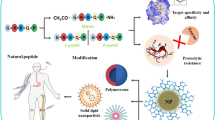Abstract
Branched peptides E(RLAR)2, E[E(RLAR)2]2, and E(KLAR)2, E[E(KLAR)2]2 were synthesized on the basis of tetrapeptides RLAR and KLAR and glutamic acid bis(pentafluorophenyl) ester. Their minimal antimicrobial concentrations were shown to decrease along with increase in branching, achieving 12 μM for Escherichia coli cells, which is comparable to antimicrobial activities of temporin, magainin, and dermaseptin. The branched peptides were found not to act on human erythrocytes.
Similar content being viewed by others
Abbreviations
- MIC:
-
minimal inhibiting concentration
References
Travis, J., Science, 1994, vol. 264, pp. 360–362.
Neu, H.C., Science, 1992, vol. 257, pp. 1064–1073.
Hancock, R.E.W. and Scott, M.G., Proc. Natl. Acad. Sci. USA, 2000, vol. 97, pp. 8856–8861.
Zasloff, M., Nature, 2002, vol. 415, pp. 389–395.
Tossi, A., Sandri, L., and Giangaspero, A., Biopolymers, 2000, vol. 55, pp. 4–30.
Op de Kamp, Y.A.F., Annu. Rev. Biochem., 2001, vol. 48, pp. 47–71.
Shai, Yc. and Oren, Z., Peptides, 2001, vol. 22, pp. 1622–1641.
Boman, H.G., Cell, 1991, vol. 65, pp. 205–207.
Blazyk, J., Wiegand, R., Klein, J., Hammer, J., Epand, R.M., Epand, R.F., Maloy, W.L., and Kari, U.P., J. Biol. Chem., 2001, vol. 276, pp. 27 899–27 906.
Ryadnov, M.G., Degtyareva, O.V., Kashparov, I.A., and Mitin, Yu.V., Biokhimiya (Moscow), 2003, vol. 68, pp. 1049–1054.
Date, M., Nikolenko, H., Meyer, J., Beyermann, M., and Bienert, M., FEBS Lett., 2001, vol. 501, pp. 146–150.
Kisfaludy, L., Löw, M., Nyeki, O., et al., Liebigs Ann. Chem., 1973, no. 9, pp. 1421–1429.
Castano, S., Desbad, B., and Dufourg, J., Biochim. Biophys. Acta, 2000, vol. 1463, pp. 68–80.
Ondetti, M.A., J. Am. Chem. Soc., 1970, vol. 92, pp. 195–197.
Gershkovich, A.A. and Kibirev, V.K., Sintez peptidov. Reagenty i metody (Synthesis of Peptides: Reagents and Methods), Kiev: Naukova dumka, 1992.
Author information
Authors and Affiliations
Corresponding author
Additional information
Original Russian Text © A.Yu. Khrushchev, I.A. Kashparov, L.V. Klimenko, Yu.V. Mitin, 2007, published in Bioorganicheskaya Khimiya, 2007, Vol. 33, No. 6, pp. 588–592.
Rights and permissions
About this article
Cite this article
Khrushchev, A.Y., Kashparov, I.A., Klimenko, L.V. et al. Branched antimicrobial peptides. Russ J Bioorg Chem 33, 544–548 (2007). https://doi.org/10.1134/S1068162007060027
Received:
Accepted:
Issue Date:
DOI: https://doi.org/10.1134/S1068162007060027




